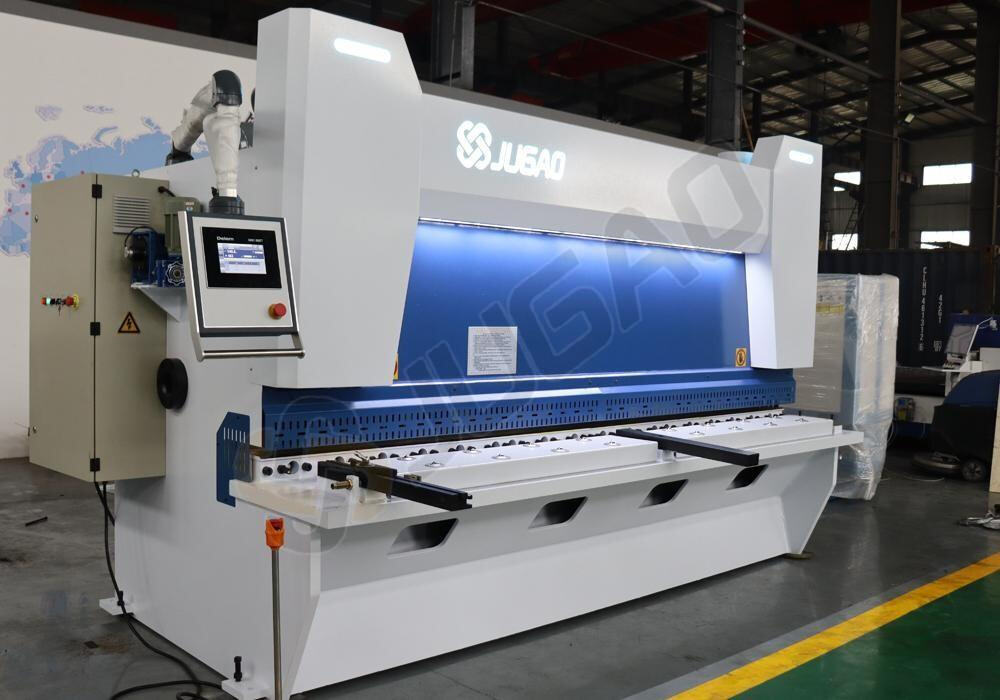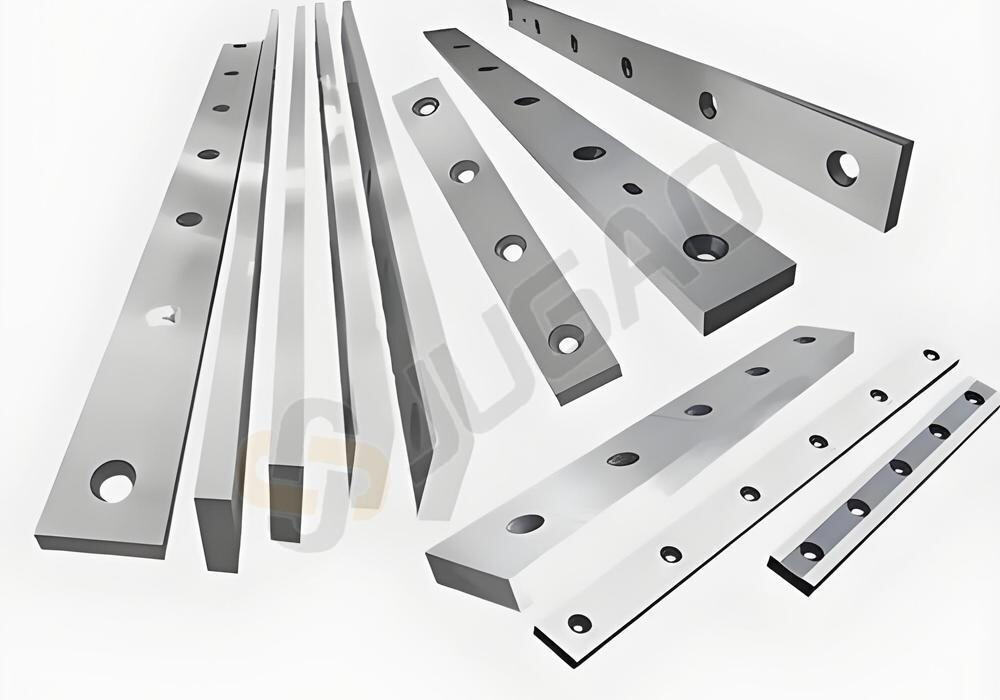The Importance of Shearing Machine Blades and How to Choose Them
Shearing machine blades are one of the core components of a shearing machine,directly determining its shearing performance, processing quality, productionefficiency, and equipment life. Blade quality plays a crucial role in productionoutcomes in industries such as sheet metal processing, machinery manufacturing,automotive, home appliance manufacturing, and construction. Let's take a closerlook at the importance of shearing machine blades.

1. The Importance of Shear Blades
1) Key Factors Determining Shear Quality
A sharp blade with appropriate hardness ensures a smooth, burr-free, andcrack-free shear surface.
Poor blade material or severe wear will result in:
Excessive shear burrs
Deformed plate edges
High workpiece scrap rates
Directly impacting the quality of subsequent processing steps such aswelding, bending, and painting.
2) Impact on Equipment Stability
Low-wear blades lack strength:
Easily break during shearing.
This causes significant vibration and abnormal impact.
In severe cases, it can damage critical components such as the blade holderand roller.
High-quality blades effectively protect the shear structure and extend itsservice life.
3) Determining Production Efficiency and Operating Costs
Durable blades extend replacement cycles and reduce downtime. Sharp bladesreduce shear resistance and increase cutting speed, thereby improving productioncapacity.
Frequent blade replacements increase:
Production downtime
Labor and commissioning costs
Repair costs
4) Directly linked to company performance
Although high-quality shear blades may cost more to purchase, they:
Excellent cutting performance, reducing scrap. Long service life, savingreplacement costs.
Reducing equipment failures and maintenance costs.
It is a key component with a one-time investment and long-termbenefits.
5) Meeting the needs of different processes and materials
Different materials (carbon steel, stainless steel, aluminum, high-strengthsteel, etc.), thicknesses, and processes (cold shearing, hot shearing) requirethe appropriate blade material.
Rational selection ensures cutting accuracy and reliability, meetingcustomers' personalized processing needs.
Comparison of the role of the blade in the entire shearing system:
| Components | MainFunctions | Isit important? |
| Shearingmachine main frame | Providessupport and transmission | Important |
| Hydraulicsystem/drive system | Providescutting force | Important |
| Blades(upper and lower blades) | Directlycompletes the cutting action | Corecomponent |
| Controlsystem | Controlscutting rhythm and length | Important |
| Positioningdevice | Preciselyfeeds materials | Minorimportance |
The shearing machine blade is the direct execution component of the "cutting"action. Without a good blade, no matter how advanced other systems are, thefinal processing effect cannot be guaranteed.
2. Consequences of Ignoring Blade Quality
Ignoring shear blade quality often leads to a series of serious consequences,not only affecting shearing performance but also causing equipment damage,reduced production efficiency, and even safety hazards. The main consequences ofignoring blade quality are as follows:

1) Key Factors Determining Shear Quality
Low sharpness and insufficient hardness: Cuts are intermittent and uneven,requiring repeated cutting.
Excessive blade wear: Large burrs and a rough cut surface.
Breakage or chipping of the blade: Sheet edges tear, bend, and becomescrapped.
Incompatibility between the blade material and the material being cut:Sheet material sticks, cracks, and shear deformation.
Result: Seriously impacts product quality, leading to rework, returns, andcustomer complaints.
2) Increased Risk of Equipment Failure and Damage
Poor-quality blades lack toughness and easily become brittle and break,transferring the shear shock to the machine body.
Prolonged use of worn blades can subject the equipment to abnormalloads.
Uneven or deformed blade edges can cause:
Uneven force on the blade holder
Irregular wear on the piston rod or blade shaft
Abnormal heating in the hydraulic system
Result: Shortened equipment life, increased repair costs, and, in severecases, equipment downtime.
3) Significantly Reduced Productivity
Frequent Blade Replacements: Increased downtime and maintenance costs
High Shear Resistance: Slower cutting speeds and reduced productioncapacity
Frequent Quality Issues: Require secondary processing or scrap, slowingproduction
Result: Limited production capacity, delayed delivery, and impacted customersatisfaction and company reputation.
4) Increased Manufacturing Costs
Low-quality blades, while inexpensive, have short lifespans and requirefrequent replacement.
This leads to increased maintenance, material waste, and increased energyconsumption.
Indirect costs can even exceed the investment in high-quality blades.
Result: "Saving money on the blades, losing money on the production line"—acostly mistake.
5) Increased Safety Risks
A broken blade can fly and cause injury.
Uncontrolled shearing can cause the sheet to slip or rebound, endangeringoperator safety.
Unstable or deformed blades increase the risk of accidents.
Result: Safety violations can lead to legal liability and even productionsuspension.
Recommendation:
It is best to choose a reputable brand or blade supplier with qualitycertifications.
Select blades of appropriate material and specifications based on thematerial being cut and the equipment being used. Check blade wear regularly andreplace them promptly.
Avoid using worn blades to minimize losses.
3. How to Choose the Right Shear Blade?
Choosing the right shear blade is key to ensuring shear quality, improvingproduction efficiency, and extending equipment life. Shear blade selectionrequires comprehensive consideration of factors such as the shearing material,shear thickness, frequency of use, and equipment type. The following is asystematic and practical guide to selecting shear blades:

1) Identify the material being cut.
Different materials require different blade performance, which is the firststep in selecting a blade.
Selection Analysis Table:
| MaterialsShearing | RecommendedBlade Materials | Features |
| Ordinarycarbon steel (Q235, Q195) | T10,9CrSi | Lowcost, moderate hardness |
| Low-and medium-alloy steel (Q345, 16Mn) | 6CrW2Si,Cr12MoV | Highstrength, excellent wear resistance |
| Stainlesssteel (304, 201, etc.) | Cr12MoV,SKD11 | Highhardness, corrosion resistance |
| High-strengthsteel, silicon steel sheet | SKD11,Powder Metallurgy Steel (ASP23) | Resistschipping and wear |
| Copper,aluminum, aluminum alloys | T8,T10 | Nomaterial damage, low cost |
| Hotshearing (hot-rolled plate) | H13 | Resiststhermal fatigue and high-temperature shear |
2) Determine the shearing thickness and frequency
Selection Analysis Table:
For thin plates (<3mm), conventional blades such as T10 and 9CrSi can beused.
For medium and thick plates (3-8mm), Cr12MoV is recommended.
For thick or high-strength plates (>8mm), high-strength materials suchas SKD11 and ASP23 are recommended.
Frequency of Use:
Low-frequency shearing → High cost-effectiveness: T10 or 9CrSi can beused.
Medium-frequency shearing → High cost-effectiveness: 6CrW2Si or Cr12MoV canbe used.
For high-frequency, high-strength shearing → Wear-resistant SKD11 or powdermetallurgy steel is more suitable.
3) Matching the shearing machine model
| Shearing machine types | Recommended Blade Materials | Description |
| Mechanical shearing machine | T10, 9CrSi | Affordable materials sufficient for the job |
| Hydraulic shearing machine | Cr12MoV, 6CrW2Si | Shear stability and long life required |
| CNC shearing machine | SKD11, ASP23 | High precision and good stability required |
| Hot shearing machine | H13 | High temperature resistance and thermal crack resistancerequired |
4) Considering both cost and lifespan
| Materials | cost | life | Applications |
| T10 | ★ | ★★ | Generalshearing, low-frequency applications |
| 9CrSi | ★★ | ★★★ | Medium-frequencyapplications for ordinary steel plates |
| Cr12MoV | ★★★ | ★★★★ | Stainlesssteel, heavy-duty shearing |
| SKD11 | ★★★★ | ★★★★★ | High-strengthsteel, precision shearing |
| ASP23 | ★★★★★ | ★★★★★★ | High-endmanufacturing, high-volume production |
Recommendation:
If your short-term budget is limited, choose cost-effective materials. Forlong-term, stable production, choose durable materials.
4. Summary
1) The Importance of Shear Blades
Determines Shear Quality: Affects the Smoothness and Accuracy of theCutting Edge
Protecting the Equipment Structure: Extends Machine Life and ReducesFailures
Improves Productivity: Reduces Blade Changes and Increases Shear Speed
Reduced Overall Cost: Reduces Hidden Costs Such as Downtime, Scrap, andRepairs
Adapts to Diverse Needs: Adapts to Shearing Tasks of Different Materialsand Processes
2) Practical Selection Steps
Confirms the Type and Hardness of the Shearing Material
Confirms the Shearing Thickness Range
Confirms the Shearing Frequency and Continuous Operating Time
Confirms the Shearing Machine Model and Operating Method
Compares Blade Life to Budgeted Cost
Selects Products from Reputable, Heat-Treated, and Quality-AssuredManufacturers


















































